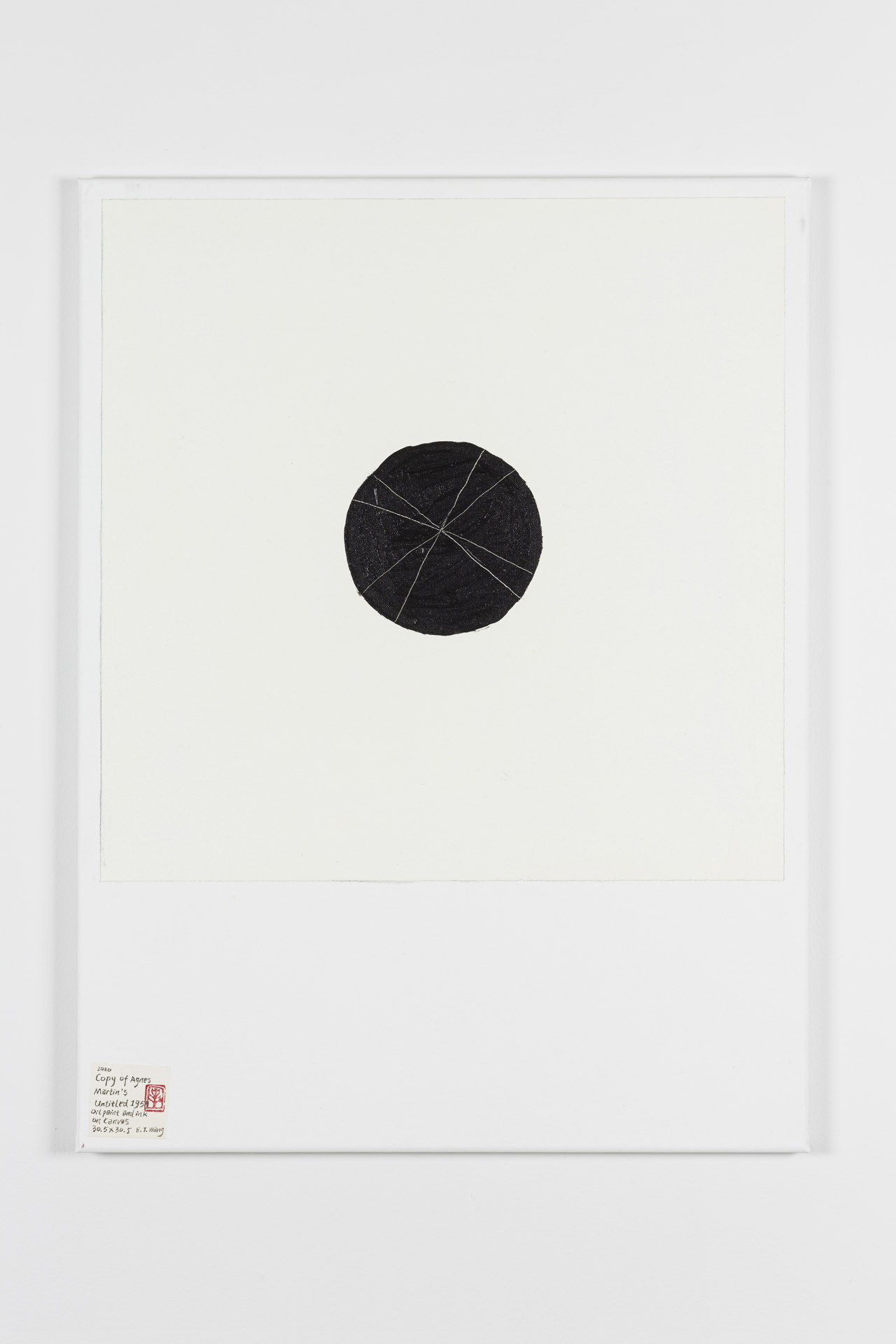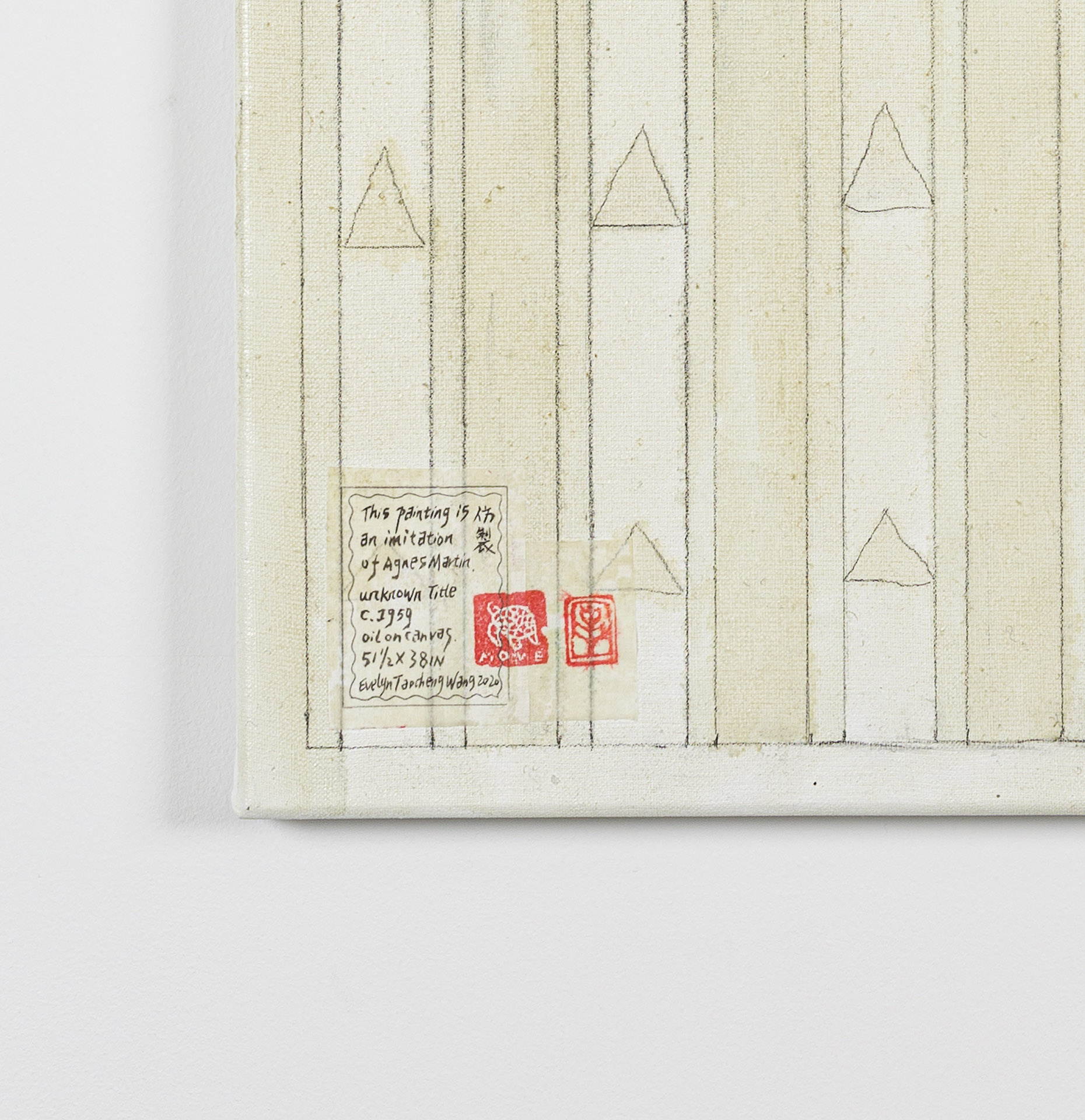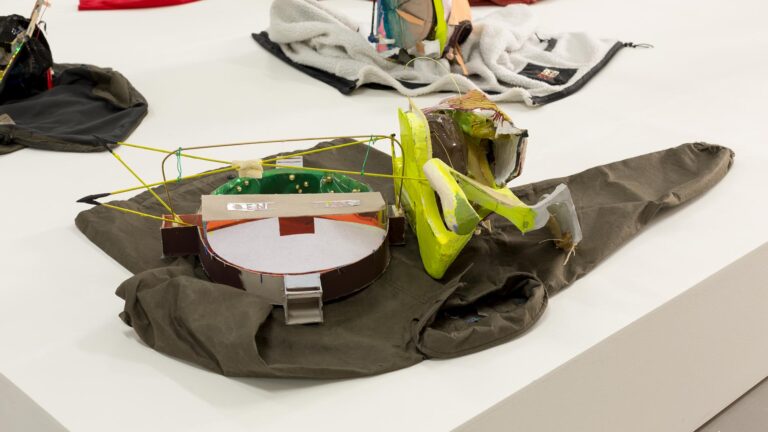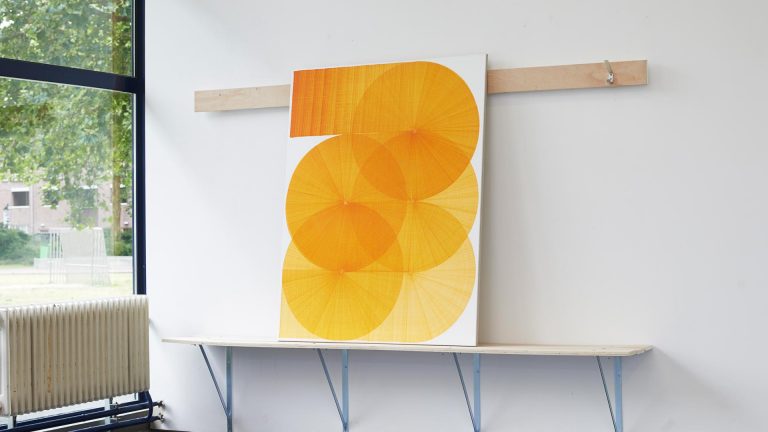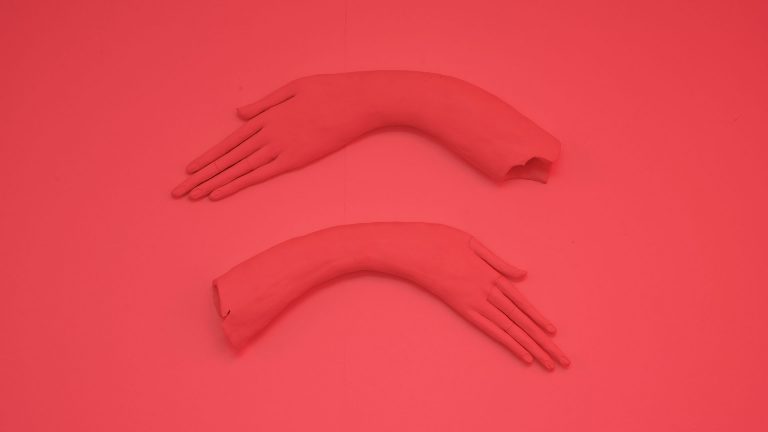Artist: Evelyn Taocheng Wang
Exhibition title: Reflection Paper
Venue: Galerie Fons Welters, Amsterdam, The Netherlands
Date: October 30, 2021 – January 8, 2022
Photography: all images copyright and courtesy of the artist and Galerie Fons Welters, Amsterdam
Q&A – Evelyn Taocheng Wang and Michelle Cotton
Michelle Cotton: The title of this exhibition at Galerie Fons Welters was also the title given to your recent exhibition at the Kunstverein für die Rheinlande und Westfalen, Düsseldorf. There you described Reflection Paper as a ‘clinic’ for purging ‘bad energy’, and presented the sculptural works and the works on canvas shown here. There was a strong performative element to this exhibition, both in the way in which the way visitors were invited to interact with or activate the sculpture but also in your copies of Agnes Martin paintings from plates in a catalogue. Can you tell us about the role of performance in your work?
Evelyn Taocheng Wang: I try to understand the English term ‘performance’ with a personal temperament. I would never want to do a performance where I am standing inside or outside a space, then put on loud sound towards people who come to see me, then doing something, or acting like an alive human-body that jumped out from old oil paintings or masterpieces, doing something like body rub against another body. For my work, I don’t want to assert any definitions about performance, and I want that my performance demonstrates metaphors, trifles of things, piece-meals, or to pick up some texts from gossip, or from reading books. My performances are always in between, are they real theatre plays, or a reading group organised with friends.
I see my own ‘Chinese painting’ as a performance, it is a metaphor of ‘ink on paper’ and at the same time it also gives a nod to the term ‘Oil on Canvas’; Copying Martin’s painting (I call it as the appropriation of a beautiful mind) is a performance I learnt from art students and children who tried their best to ‘become that one’, so when I copy her paintings, I become that beauty of her painting. Performance for me is about not wanting to become the star, but wanting to be the moon. My performance takes on a lot of roles at the same time, they are not only one storyline. Like in my video work Reflection Paper, it has so many subtitles and voice-overs playing at the same time, the texts and images need to squeeze their identities out, those texts are ‘make-up’ of images, and sometime ‘no-make-up is also a make-up’.
MC: The way that you talk about performance reminds me of (Anton) Chekhovian theatre, where there is no single protagonist but rather a chorus of characters that develop a ‘drama of mood’. How do you see the role of the sculptures in this exhibition?
ETW: I have been wondering about what is the mood of humankind? How have they worked with art? Are they reflecting history of humanity? Are they tightly connected onto our thoughts? Are those thoughts often happening in paralleled contexts, or crossed illuminations, like grids or woven textures of thinking, echoed interpretations. Shall I say a bit about cavalier perspective? No, I can’t. The sculptural works are all props, they are the stage, they are narrative, they are a garden, they come from opera and intuition, they are wallpaper or a background where something happens. This sculpture Thoughtless Garden was to rebuild a garden for Martin’s Clinic based on her own story of making her unfinished film about Genghis Khan. Martin thought that art is produced by a process of surrendering to our own mind, then the work of art could be made. The princess of Beijing surrendered to Genghis Khan by marrying him and then lead a very harmonious life and saved Beijing city, and rescued the garden as well. So, I thought I would produce an old garden but in a modern way, which looks like circles and columns, those white painted columns might reminiscent Greek’s ruins, where people can sit and ‘read’ those copies of Martin’s paintings; the sculptures form a stage, I hope those elements give each other comments and weaves references.
MC: To these works you have added a series of six new works on paper. They refer variously to different aspects of Dutch culture; architectural details such as stained-glass windows in the city of Rotterdam or the colourful awnings used to shade the windows from bright sunlight. Such details, observed in design or languages for instance, seem to figure in your work as part of a cultural idiom, variously emblematic of Dutchness or Germanness or Frenchness. Can we view these architectural features as emblematic of something specific to the Netherlands and its people?
ETW: Those paper window works are not based on specific research or specific houses and their history. They are inspired by a touristy act, a cinematic fantasy which I planned cycling around the city and trying to remember those windows and shaping them into a general image by memory. Windows reflect lights, memory reflects thoughts, both are depicted in those works on paper. Memory is a core part of learning a new cultural language, using new words and grammar which we speak everyday out of habit. Architectural elements are, to me, like a metaphor of memorizing my thoughts and digesting a new culture around me. Our memory – such as those lights reflected onto those windows – could be forgotten. For example, so many old houses had different memories before being gentrified from an old women hofje to a hipster shop, but also, they could be remembered forever in our mind, if our brain did not age and lost its memory. Those windows are my memory from an old Rotterdam house which existed since the Second World War, or at least it looks like an old house. They are the wounds of thoughts on the body of a city. This series is a personal experience of another culture, but it remains intuitive and fresh with first impressions of architectural elements.
I can’t completely understand a culture (including the culture where I was born), it’s a foreign language. The clichéd image of the Dutch – Dutch minimalist architecture, very neat, no-drama, open curtains, tulip gardens behind Dutch windows, rain all the time – still exists in my head and is deeply ingrained on my memory. Vermeer’s paintings, which I saw initially when I was still in China, I wish I could forget them completely. But then the question is, if I forget these things that are the reason that I want to stay, because of my happy memories of Dutch art history, then how shall I keep my motivation to learn its language perfectly. If people who are born in the Netherlands who speak very good Dutch may, in mid-conversation, notice that you are not born in the Netherlands as a white Dutch person and change directly to speaking English. This process disturbs another process of understanding Dutch culture. Those paper paintings are a bit like illustrations painted in children’s books which are written by a simple brain in this complicated world.
MC: The paper is stained with tea and the finished drawing authenticated with stamps carved from jade. These are playful, performative gestures too that subvert another set of cultural codes. I see this playful subversion repeatedly in your works and I would also characterise it as feminine. Tanning paper with tea is perhaps not so different to the wartime practice of painting ‘hosiery’ on your legs with gravy browning. What role does humour play in your work and are you conscious of this distinctly feminine character?
ETW: The female temperament is like water, male temperament is like mud. Tea represents rational satisfaction and being solitary, it is opposite from a wine-god motif, and comparing to coffee, it contains less caffeine – a different form of drug. For me it is a medium which is called, a bit fashionably perhaps, a neutraliser. It is not women, not men. Technically, it gives a slight yellowish layer, which relates it to skin colour. If I show my work in China, a professional traditional painter will doubt to classify my work on paper as Chinese painting, many friends assert that they are too obviously ‘Westernised education’, and from another point of view: I need to do more homework and stop fabricating my image of ‘making Spring Roll’ in western contemporary context of art history. Many older generations of male artists, living in Europe, played such a ‘Spring Roll’ of an image of an ‘Asian artist’, I follow them, but I want to get out halfway, to sneak into a beauty salon or a bookstore.
My work is rarely about ‘Universal Art’, we are just tiny little humans in this universe, we talk to each other, we love each other, then we don’t talk and keep distance from each other – what a group animal! I want to be more pragmatic and humbler, my work is ‘very little tiny universal’.
The ‘rice paper’ is not made with rice, it is made by Tanshu (sandalwood). Before I learnt Chinese traditional painting, I was learning oil on canvas because the art school entry exam requires it. Oil on canvas was richly trained in realistic figurative work. I was laughing at canvas and referred to it as ‘Bread-Canvas’.
I finally decided to study the paper and ink techniques and calligraphy, because to me paper means revelation and openness, with its fragile and hyper-sensitive reception to ink and pigment. This paper allows me and never makes me feel being rejected, because it prints and record my body-strength, my mood while I write or paint a texture-stroke on it. And oil painting for me means a ‘finish’, a closure, and a full ego which is ‘rationally constructed and with strategy’. The so called ‘rice-paper’ is so sensitive, it is more true to ‘painting’ for me than any oil on canvas. If I paint a line on the paper, it cannot hide, it is a wound, the scar is forever there even if it won’t be shown so directly and is sunk into the paper, a temporal mark with material, a gesture.
Paintings on canvas are more like drawings to me, they are like make-up, and layer by layer, create a perspective. Oily flesh kind of objects, that remind me of cosmetics that someone wears, or even hires a professional make-up salon for, to apply certain shade and create a ‘sculpture’ on your face. The rationality of oil, is about cover, piled up, erasing, and fabricating a rational lie; and of course, wearing such heavy make-up we might think subjectively that her face looks still natural, but if I wear such heavy make-up by purpose, then it means something else.
I am happy to show with Willem de Rooij this time because his work focuses on the two terms of an image which can be seen as ‘perception’ and is explained as ‘interpretation’. Therefore, oil on canvas represents a heroic kind of masculinity, spreading assertions of nihilism and its ego. Paper makes me write, it demands sensibility and expression of thoughts with feeling, and painting relates to ‘making it’, to achievement, it is hung in a museum hall or action market like a sublime church, and a church is less cosy than your home. In the Netherlands, many old churches changed into domestic homes by real estate companies, I think if I were going to move in, the first step is to move out all the paintings and hang a few papers of poems as decorations.
I am not saying that an oil on canvas can’t be ‘sensitive’, but it can’t represent the peaceful ocean of openness, it can’t represent a circle of four seasons, it is too vertical and self-entitled. The only oil painting I really think that can be interpreted as painting is text work writing on canvas, to write down what is Nicolas Poussin on canvas.
Sometimes I see different cultures as different levels of a masculine-temperament or feminine-temperament. German culture for example is more masculine than the rest of the EU, because they produce heavy industry and ‘Maschinenbau’. Japanese culture has quite a feminine temperament though it seems so male dominated, maybe because the long and sentimental theory on the beauty and sadness of cherry blossom.
MC: What bad energies would you most like to purge with this exhibition?
There are two pieces of oversized grandmother underwear (actually they are dresses for men and women I design via my own artistic cloth name E.T.Wang by Studio E.T.Wang, it is not really a brand but also not only sewed by myself). In the exhibition, they are producing positive energy, to give more balance. You can wear it and jump into the air, sit on the face of the person that wants to touch you in the crowded subway, you know, those horrible embarrassing moments. Actually, there isn’t a clear line of dividing bad and good energy in a space where works of art are shown. Let’s go back to Agnes Martin, she can build her own Adobe house in the desert in Taos, all by her own hands – who even dares to grossly touch her without permission? On the earth, we are briefly a performer. Thank you for taking part in our conversation.
Evelyn Taocheng Wang (China 1981, lives and works in Rotterdam) studied painting in China before attending the Städelschule, Frankfurt. From 2012-2014 she was resident artist at De Ateliers, Amsterdam. She has won the ABN AMRO Art Award (2019) Dolf Henkes Prize (2019) as well as the Dorothea von Stetten Award and the Volkskrant Beeldende Kunst Prize (both 2016). She has had solo shows at Kunstverein für die Rheinlande und Westfalen, Düsseldorf, Germany; Museum Abteiberg, Mönchengladbach, Germany; Hermitage Amsterdam, The Netherlands; KevinSpace, Vienna, Austria; FRAC Champagne-Ardenne, Reims, France; KW – institute for contemporary art, Berlin, Germany; Vrienden van het SMAK, De Vereniging, Ghent, Belgium; Frans Hals Museum | Hallen Haarlem, The Netherlands; Carlos|Ishikawa, London, United Kingdom and Galerie Fons Welters, Amsterdam, The Netherlands and participated in Manifesta 11, Zurich, Switzerland; as well as groupshows Centre Pompidou, Paris, France; WIELS, Brussels, Belgium and Stedelijk Museum Amsterdam, The Netherlands. Her performances have been presented at Stedelijk Museum Amsterdam, The Netherlands as well as Documenta 14, Kassel, Germany. Wang’s work has been collected by amongst others the Art Institute of Chicago, Chicago, United States; Bonnefanten Museum, Maastricht, The Netherlands; Centre Pompidou, Paris, France; Stedelijk Museum Amsterdam, The Netherlands and FRAC Champagne-Ardenne, Reims, France.
Michelle Cotton is an art historian and head of programme at MUDAM, Luxembourg.
Evelyn Taocheng Wang, Reflection Paper, 2021, exhibition view, Galerie Fons Welters, Amsterdam
Evelyn Taocheng Wang, Reflection Paper, 2021, exhibition view, Galerie Fons Welters, Amsterdam
Evelyn Taocheng Wang, Reflection Paper, 2021, exhibition view, Galerie Fons Welters, Amsterdam
Evelyn Taocheng Wang, Reflection Paper, 2021, exhibition view, Galerie Fons Welters, Amsterdam
Evelyn Taocheng Wang, Reflection Paper, 2021, exhibition view, Galerie Fons Welters, Amsterdam
Evelyn Taocheng Wang, Reflection Paper, 2021, exhibition view, Galerie Fons Welters, Amsterdam
Evelyn Taocheng Wang, Reflection Paper, 2021, exhibition view, Galerie Fons Welters, Amsterdam
Evelyn Taocheng Wang, Reflection Paper, 2021, exhibition view, Galerie Fons Welters, Amsterdam
Evelyn Taocheng Wang, Reflection Paper, 2021, exhibition view, Galerie Fons Welters, Amsterdam
Evelyn Taocheng Wang, Reflection Paper, 2021, exhibition view, Galerie Fons Welters, Amsterdam
Evelyn Taocheng Wang, Reflection Paper, 2021, exhibition view, Galerie Fons Welters, Amsterdam
Evelyn Taocheng Wang, Reflection Paper, 2021, exhibition view, Galerie Fons Welters, Amsterdam
Evelyn Taocheng Wang, Reflection Paper, 2021, exhibition view, Galerie Fons Welters, Amsterdam
Evelyn Taocheng Wang, Reflection Paper, 2021, exhibition view, Galerie Fons Welters, Amsterdam
Evelyn Taocheng Wang, Reflection Paper, 2021, exhibition view, Galerie Fons Welters, Amsterdam
Evelyn Taocheng Wang, Reflection Paper, 2021, exhibition view, Galerie Fons Welters, Amsterdam
Evelyn Taocheng Wang, Reflection Paper, 2021, exhibition view, Galerie Fons Welters, Amsterdam
Evelyn Taocheng Wang, Reflection Paper, 2021, exhibition view, Galerie Fons Welters, Amsterdam
Evelyn Taocheng Wang, Reflection Paper, 2021, exhibition view, Galerie Fons Welters, Amsterdam
Evelyn Taocheng Wang, Reflection Paper, 2021, exhibition view, Galerie Fons Welters, Amsterdam
Evelyn Taocheng Wang, Reflection Paper, 2021, exhibition view, Galerie Fons Welters, Amsterdam
Evelyn Taocheng Wang, mentale roep in harde architecturale wind, 2021, ink, acrylic, pigments, artist’s seals on paper, mounted with paper, 73 x 48 cm
Evelyn Taocheng Wang, Gek op je!, 2021, ink, acrylic, pigments, artist’s seals on paper, mounted with paper, 70 x 45 cm
Evelyn Taocheng Wang, Scooter, Whatsapp en Zonnescherm, 2021, ink, acrylic, pigments, tea, artist’s seals on paper, mounted with paper, 74 x 50 cm
Evelyn Taocheng Wang, Clinic Agnes Martin, OP. 4, 2020, oil, pencil on linen canvas, 100 x 100 cm
Evelyn Taocheng Wang, Clinic Agnes Martin, OP. 4, 2020, oil, pencil on linen canvas, 100 x 100 cm
Evelyn Taocheng Wang, Clinic Agnes Martin, 2020, oil and graphite on canvas, 80 x 60 cm
Evelyn Taocheng Wang, Clinic Agnes Martin, 2020, oil and graphite on canvas, 80 x 60 cm
Evelyn Taocheng Wang, Clinic Agnes Martin, 2020, oil and graphite on canvas, 100 x 80 cm
Evelyn Taocheng Wang, Clinic Agnes Martin, 2020, oil and graphite on canvas, 100 x 80 cm
Evelyn Taocheng Wang, Clinic Agnes Martin, 2020, oil and graphite on canvas, 100 x 80 cm
Evelyn Taocheng Wang, Clinic Agnes Martin, 2020, oil and graphite on canvas, 100 x 80 cm
Evelyn Taocheng Wang, Clinic Agnes Martin, 2020, oil and graphite on canvas, 80 x 60 cm
Evelyn Taocheng Wang, Clinic Agnes Martin, 2020, oil and graphite on canvas, 80 x 60 cm
Evelyn Taocheng Wang, Clinic Agnes Martin, 2020, oil and graphite on canvas, 80 x 60 cm
Evelyn Taocheng Wang, Clinic Agnes Martin, 2020, oil and graphite on canvas, 80 x 60 cm
Evelyn Taocheng Wang, Clinic Agnes Martin, OP. 5, 2020, oil, pencil on linen canvas, 100 x 80 cm
Evelyn Taocheng Wang, Clinic Agnes Martin, OP. 5, 2020, oil, pencil on linen canvas, 100 x 80 cm
Evelyn Taocheng Wang, Dutch Window in Afternoon Sun, 2021, ink, pencil, acrylic, pigments, tea, artist’s seals on paper, mounted with paper, 75 x 48,5 cm
Evelyn Taocheng Wang, Dutch Window in Moon Light, 2021, ink, pencil, acrylic, pigments, tea, artist’s seals on paper, mounted with paper, 75 x 48,5 cm
Evelyn Taocheng Wang, Dutch Window in Rainy Football Stadium, 2021, ink, pencil, acrylic, pigments, tea, artist’s seals on paper, mounted with paper, 75 x 48,5 cm



































